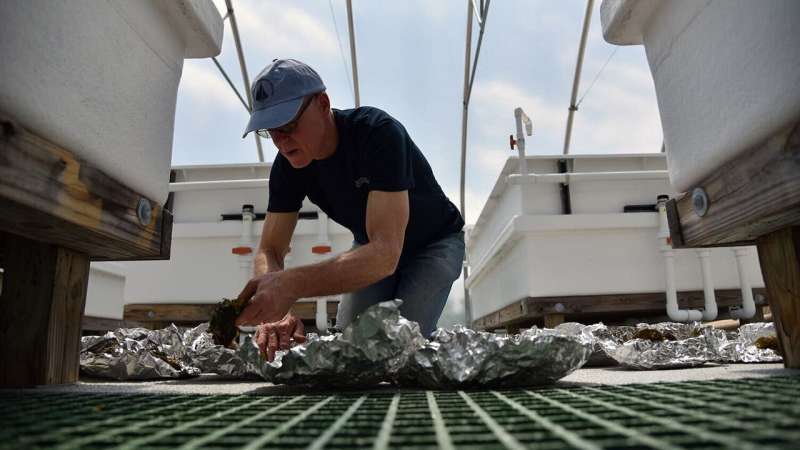Growing a better seaweed to fuel the future

"Thirteen point two." One scientist calls out the measurement; another jots it down in her data sheet. It's hot and stuffy in the lab, and the pungent smell of seaweed is inescapable as the team sits for hours at a black table measuring blades of sugar kelp—brownish seaweeds that look like oversized slabs of bacon.
"Nine point four." Another data entry.
Using a mix of rulers, calipers, and measuring tapes, a dozen scientists—a seaweed science task force—are sizing up thousands of individual kelp blades recently harvested from a research farm in New England in order to find the best specimens for selective breeding. It's a long, exacting process, but for Woods Hole Oceanographic Institution (WHOI) biologist Scott Lindell, it's a key step toward turning the ocean crop into a global energy source for the future.
"This is groundbreaking work since it's the first time in North America that anyone has phenotyped, or measured many traits, in a seaweed crop—something we take for granted with land-based agriculture," said Lindell.
Big biofuel potential
The work will enable the scientists to breed better kelp—strains that can tolerate the harsh offshore conditions in which they will be grown. The U.S. Department of Energy's (DOE) Advanced Research Projects Agency-Energy (ARPA-E) is funding the research, as part of a broader effort aimed at advancing the mass production of seaweed for biofuels. The idea is simple: Grow kelp on a large scale in offshore farms and turn it into biofuels that could one day power millions of homes and cars.
To maximize the crop, Lindell, along with colleagues from the University of Connecticut (UConn) Stamford, the USDA Agriculture Service at Cornell, and ocean farmer training non-profit GreenWave, have developed a kelp breeding program designed to produce strains that are not only more resilient to the elements, but ones that yield 30 percent more than wild kelp over the life of the project. This, according to UConn seaweed scientist Schery Umanzor, is where the tedious measurements come into play.
"We're doing exactly what traditional agriculture has done for 10,000 years, only in this case we're working with plants from the ocean," she said. "As we measure each blade, we're looking for those with short stems or "stipes" and slender blades roughly the width of a waist belt, which makes the blades more streamlined and less apt to break in turbulent waters. We're also looking for heavy blades with good biomass."
Finding the best of the bunch is just the first step. Next, the researchers will extract spores from the optimal strands, combine them with hundreds of others in a seed bank at WHOI and UConn, and genotype them to determine differences in their genetic make-up before crossbreeding them to produce a second generation. The new strains will be planted on lines in offshore farms around New England in October.
Cool species, warming ocean
If things go according to plan, the kelp harvested in the spring of 2020 should be larger, heartier, and more abundant than the parent plants—bringing the team one step closer to breeding the "ideal" seaweed for creating biofuel. But Lindell points out that kelp is a cool water species, and warming ocean temperatures could have a negative effect on yields.
"As the ocean continues to heat up, it increases the number of organisms that foul and consume the kelp blades and leads to their decline," he said. "We have already seen kelp beds getting thinner in some parts of New England, and in some cases, we no longer see kelp in places where it used to grow. Warming also means there's a shorter season for farming, which ultimately affects the amount that can be grown and harvest."
On the flipside, kelp farms can play a role in the fight against global warming. They act as a carbon sink by sucking up vast amounts of dissolved carbon dioxide from the oceans. In the process, kelp can also elevate pH levels in their immediate surroundings and supply oxygen to help mitigate local effects of ocean acidification. And, since kelp can be converted into new fuel sources, it has the potential to reduce greenhouse gasses and our dependence on fossil fuels—one of the main goals of the program to begin with.
Energy of tomorrow
The potential advantages are clear, but can we grow enough seaweed to fuel our future?
"Ocean farmers are currently making a good living selling kelp to supply a new culinary trend," said Lindell. "But as the industry grows and gets more efficient using the tools developed by DOE and other funded research, the production cost of kelp will likely drop in the coming decades. It is more environmentally sustainable and will become more competitive than other biofuels and fossil fuels."
"In a hotter and drier world of the future," he adds, "it will be hard to find a better resource for biofuels than farmed seaweeds that require no arable land, no fresh water, and no fossil-fuel-derived fertilizer in contrast to modern land crops."
Provided by Woods Hole Oceanographic Institution



















